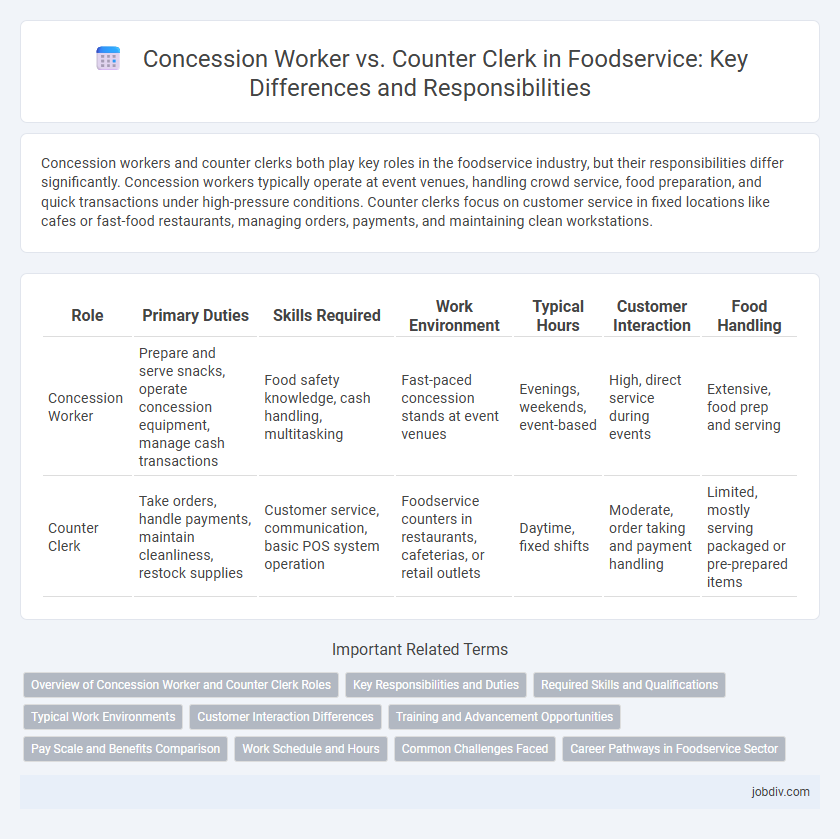Concession workers and counter clerks both play key roles in the foodservice industry, but their responsibilities differ significantly. Concession workers typically operate at event venues, handling crowd service, food preparation, and quick transactions under high-pressure conditions. Counter clerks focus on customer service in fixed locations like cafes or fast-food restaurants, managing orders, payments, and maintaining clean workstations.
Table of Comparison
| Role | Primary Duties | Skills Required | Work Environment | Typical Hours | Customer Interaction | Food Handling |
|---|---|---|---|---|---|---|
| Concession Worker | Prepare and serve snacks, operate concession equipment, manage cash transactions | Food safety knowledge, cash handling, multitasking | Fast-paced concession stands at event venues | Evenings, weekends, event-based | High, direct service during events | Extensive, food prep and serving |
| Counter Clerk | Take orders, handle payments, maintain cleanliness, restock supplies | Customer service, communication, basic POS system operation | Foodservice counters in restaurants, cafeterias, or retail outlets | Daytime, fixed shifts | Moderate, order taking and payment handling | Limited, mostly serving packaged or pre-prepared items |
Overview of Concession Worker and Counter Clerk Roles
Concession workers operate food and beverage stands at venues such as stadiums and theaters, handling customer orders, processing payments, and maintaining cleanliness in fast-paced environments. Counter clerks typically serve customers in cafeterias or retail food establishments, taking orders, assembling food items, and managing cash registers with a focus on customer service and accuracy. Both roles require strong communication skills, attention to hygiene standards, and the ability to work efficiently during peak hours.
Key Responsibilities and Duties
Concession workers manage food preparation, serving snacks, and operating concession stands to ensure quick customer service during events. Counter clerks handle cash registers, take customer orders, and maintain cleanliness at foodservice counters, emphasizing order accuracy and timely transactions. Both roles require customer interaction, but concession workers focus more on food handling, while counter clerks emphasize sales and customer service efficiency.
Required Skills and Qualifications
Concession workers require strong customer service skills, quick cash handling abilities, and proficiency in operating concession equipment such as popcorn machines and soda dispensers. Counter clerks need excellent communication skills, experience with point-of-sale (POS) systems, and a solid understanding of food safety regulations to efficiently manage customer orders and maintain cleanliness. Both roles demand teamwork, attention to detail, and the ability to work in fast-paced environments.
Typical Work Environments
Concession workers typically operate in stadiums, amusement parks, or movie theaters, where they manage high-volume food sales in fast-paced, crowded environments. Counter clerks usually work in cafes, diners, or fast-food restaurants, serving customers directly from a fixed counter with a focus on personalized service. Both roles demand efficiency and customer interaction but differ in the nature and setting of their foodservice operations.
Customer Interaction Differences
Concession workers primarily engage with customers in fast-paced environments, handling quick transactions and offering limited menu options, which demands efficient service and clear communication. Counter clerks often manage more complex orders and provide personalized recommendations in casual dining or retail settings, fostering longer interactions that enhance customer satisfaction. Both roles require strong interpersonal skills, but concession workers emphasize speed and accuracy, while counter clerks focus on detailed product knowledge and customer rapport.
Training and Advancement Opportunities
Concession workers typically receive on-the-job training focused on food safety, customer service, and operating concession equipment, with advancement opportunities leading to shift supervisor or concession manager roles. Counter clerks often undergo comprehensive cash handling, order processing, and customer interaction training, enabling progression into front-of-house management or inventory control positions. Both roles emphasize skill development in fast-paced environments, but counter clerks generally have broader pathways toward administrative and supervisory careers within the foodservice industry.
Pay Scale and Benefits Comparison
Concession workers typically earn an hourly wage ranging from $10 to $15, reflecting the physically demanding nature of their roles in foodservice venues like stadiums and theaters, while counter clerks usually receive between $12 and $18 per hour due to responsibilities involving customer interaction and order processing. Benefits for concession workers often include limited access to healthcare and few paid leave options, whereas counter clerks employed by larger foodservice operations may receive comprehensive health insurance, retirement plans, and paid time off. Pay scale variations and benefit packages largely depend on the employer size and location, with unionized workplaces offering more structured compensation for both positions.
Work Schedule and Hours
Concession workers often have flexible work schedules with peak hours during events, evenings, and weekends, resulting in irregular shifts that can include late nights. Counter clerks typically work more consistent hours, frequently following standard business hours with potential shifts spanning mornings to early evenings, and often include weekends. Both roles may require part-time or full-time availability, but concession workers generally experience more variable and event-driven schedules.
Common Challenges Faced
Concession workers and counter clerks in foodservice frequently encounter challenges such as managing high customer volumes during peak hours and maintaining speed without compromising order accuracy. Both roles demand effective communication skills to handle diverse customer requests and resolve complaints swiftly. Additionally, they face physical strain from long hours of standing and repetitive tasks in fast-paced environments.
Career Pathways in Foodservice Sector
Concession workers often start in entry-level roles handling food preparation and customer service at event venues, gaining valuable skills in fast-paced environments. Counter clerks typically advance by developing expertise in order-taking, cash handling, and inventory management, positioning themselves for supervisory roles within foodservice outlets. Career pathways in the foodservice sector enable progression from concession worker or counter clerk positions to management roles such as shift leader, assistant manager, or restaurant manager, emphasizing operational efficiency and team leadership.
Concession Worker vs Counter Clerk Infographic

 jobdiv.com
jobdiv.com